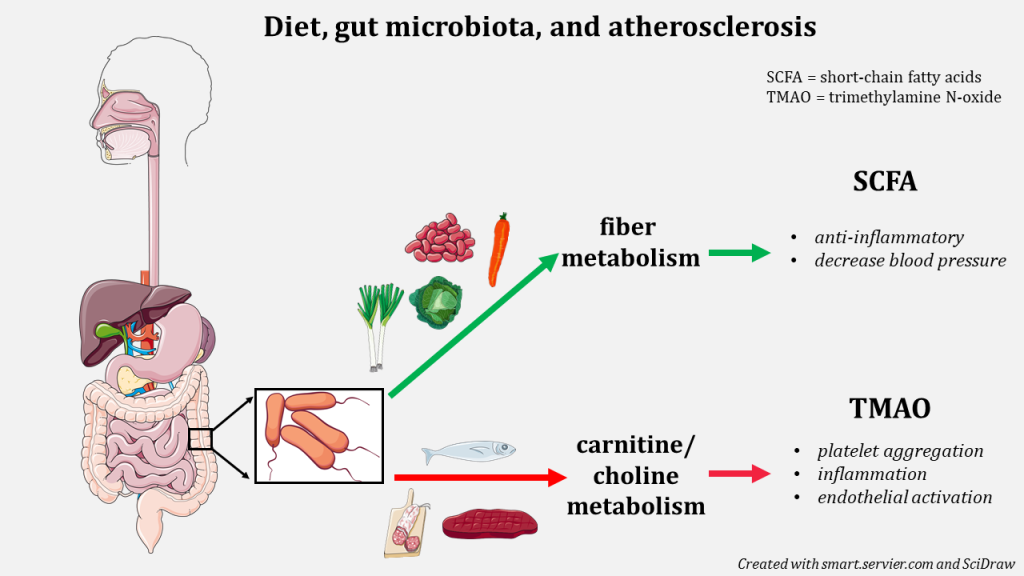Atherosclerosis and Angina
Tetiana Povshedna
The role of gut microbiota is actively being investigated in the context of cardiovascular disease in the past few decades. Some evidence implicating gut and oral microbiota in the development and progression of cardiovascular disease include altered microbial composition in individuals with CVD compared to controls and bacterial DNA in atherosclerotic plaques. While mechanistic understanding of the relationship between microbiota and clinical outcomes is still lacking, multiple studies have pointed toward associations and mechanisms which might connect gut microbiota and the development of atherosclerosis. Some of these diet-related mechanisms are highlighted below and point toward possible behavioral interventions that could be incorporated into atherosclerosis prevention strategies if proven causal. So far, most of the data in the field are coming from animal studies, and there is no consensus about the relationship between diet, gut microbiota, and atherosclerosis. Thus, the research findings should not be interpreted as dietary or medical advice.
Possible mechanisms that connect diet, gut microbiota, and atherosclerosis (Figure 8.36)
Short-chain fatty acids
Changes in intestinal wall permeability (the “leaky gut” concept), which occur in multiple disease states, including cardiovascular, allow for the transport of bacterial metabolites through the intestinal wall into the systemic circulation. Once in the systemic circulation, molecules produced by gut microbiota can induce a pro-inflammatory state in the host which, in turn, can worsen existing chronic conditions, including atherosclerosis. At the same time, some molecules produced by bacteria can have anti-inflammatory properties. The gut microbiota-derived short-chain fatty acids, which are produced during fiber fermentation by bacteria, can decrease blood pressure ( a known risk factor for atherosclerosis), as shown in some animal and human studies. This possible link presents an interesting avenue for behavioral and therapeutic interventions and an opportunity to leverage the benefits of plant-based diets.
Trimethylamine N-oxide (TMAO)
TMAO is a dietary component that’s produced by gut microbiota as a result of phosphatidylcholine, choline, and carnitine (contained in red meat, eggs, fish) metabolism. Some studies have found an association between higher amounts of this molecule, the likelihood of cardiovascular events (heart attack, stroke), and atherosclerosis severity. Some proposed mechanisms include TMAO’s ability to facilitate platelet aggregation (a necessary step of clot formation), inflammation (a risk factor of atherosclerosis), and endothelial activation (often the first step in atherosclerosis lesion initiation). A possible link between the amount of red meat consumption, TMAO levels, and the likelihood of ASCVD points towards the importance of dietary considerations for atherosclerosis prevention.

As the body of evidence connecting gut microbiota and cardiovascular disease grows, scientists are exploring microbiota-targeted interventions to prevent atherosclerosis progression. These include:
- use of prebiotics (food/supplements that are used by beneficial gut microbiota)
- use of probiotics (foods/supplements that contain live microorganisms)
- TMAO production inhibitors
- dietary measures (variations of the plant-based diet with high dietary fiber and fermentable substrates content)
- targeting “leaky” intestinal membranes
Section summary
New research suggests that metabolites produced by gut microbiota can affect atherosclerosis development and progression. Numerous animal and human studies have shown intriguing associations between certain dietary patterns and atherosclerosis risk/outcomes. However, since the causal relationships between various diet components and atherosclerosis outcomes have not been established, these data should be interpreted with caution.
Review questions
1. Finish the following sentence. The term “microbiota” refers to:
- Bacteria
- Fungi
- Parasites
- Bacteria, fungi, and viruses enhabiting a multicellular organism
2. Bacterial metabolites produced during fibre fermentation might decrease risk of atherosclerosis.
- True
- False
3. Fill in the blank.
One of the choline metabolites, _____, is pro-inflammatory and can increase risk of atherosclerosis.
Answer Key
- Bacteria, fungi, and viruses enhabiting a multicellular organism
- True
- TMAO
References
https://www.nature.com/articles/nrcardio.2016.183#Ack1
https://www.ahajournals.org/doi/10.1161/CIRCRESAHA.120.316242
https://openheart.bmj.com/content/6/1/e000993
https://bsd.biomedcentral.com/articles/10.1186/s13293-021-00378-z#rightslink
Media Attributions
- Gut microbiota © Tetiana Povshedna is licensed under a CC BY-NC (Attribution NonCommercial) license
collection of microorganisms (bacteria, fungi, viruses, and other) in person's gastrointestinal system
a metabolite that's produced by gut microbiota as a result of dietary fiber fermentation
acute atherosclerotic cardiovascular disease

